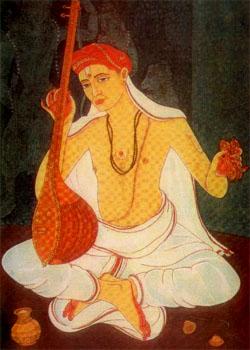Tyagaraja
|
|
Sri Tyagaraja (శ్రీ త్యాగరాజ) (17??-1848), an ardent devotee of Sri Ramachandra, was one of the most important composers of Carnatic music. He is regarded as being one of the "Trinity" of Carnatic music composers, the other two being Muthuswami Dikshitar and Shyama Sastry.
| Contents |
Personal Life
In Thiruvarur in the Tanjavur district of present-day Tamil Nadu, in the Hindu lunar year Sarvajit 27th Soma, on Sukla saptami, the seventh day of the bright half of the Hindu month of Chaitra, under the Pushya nakshatram [star], that is on 4th May 1767, a son was born to Kakarla Ramabrahmam and his wife Seethamma. According to another tradition, the year of his birth was 1759. The boy was named Tyagaraja, after Lord Tyagaraja, the presiding deity of Thiruvarur. His maternal grandfather, Giriraja Kavi, was a poet-composer attached to the court of Tanjavur. The family was a pious Telugu-speaking smartha brahmin family of the vaidiki Mulukanadu sub-caste. They are said to have hailed from a village named Kakarla in the Kurnool district of present-day Andhra Pradesh, but had long been settled in Thiruvaiyaru in the Thanjavur district of present-day Tamil Nadu, which is the scene of the life and work of the great composer.
Tyagaraja was married at a young age to a lady named Parvatamma, who died briefly afterwards without issue. He was then married to Kamalamba, by whom he had one child, a daughter named Seethalakshmi, who was wed in the fullness of time to a gentleman by name Kuppuswamy. Seetalakshmi's only child was also called Tyagaraja. He died at a young age and with that, the direct line of Tyagaraja came to an end. Thyagaraja had an elder brother, Japyesa, whose descendents still abide in the same area of Tamil Nadu. Japyesa is often made a villain in stories about Tyagaraja as the brother that could not understand Tyagaraja's devotion to Sri Rama. Thyagaraja attained release from the material world on Pushya Bahula Panchami, the fifth day of the dark half of the month of Pushya, in the Hindu lunar year Prabhava (6th January, 1847).
Life and work
Education and purpose
Tyagaraja started his musical training under Sri Sonti Venkataramanayya at an early age. Tyagaraja regarded music as a way to experience the love of God. His objective while performing music was to repeat the name of God and contemplate on His Divine Pastimes, thereby reducing the vices of the mind, not to display his mastery over Raga and Tala. He had to struggle quite a bit to compose music in which Bhava, that is, emotion, was crowned. (He always felt that Bhava was not to be compromised for Raga and Tala). The legend goes that he was blessed by the divine sage Narada with great musical knowledge. He is said to have sung Sadhinchane, the third of the Pancharatna Kritis, on this occasion.
Career
As a 13 year old, he composed Namo Namo Raghava in Desikathodi. Much later in life, his guru, Sonti Venkataramanayya, wanted to listen to Tyagaraja's new talent and invited him to perform at his house in Thanjavur. On that occasion, Tyagaraja presented Endaro Mahaanubhavulu(ఎందరో మహానుభావులు), the fifth of the Pancharatna Krithis.
Intensely pleased with Tyagaraja's song, Sonti Venkataramanayya told the king about the genius of Tyagaraja. The king sent an invitation, accompanied as was traditional with many rich gifts, to Thyagaraja, inviting him to grace the royal court. To the unworldly Tyagaraja, the prospect of wealth or fame was no incentive; he clearly had no inclination for a career life at court, which doubtless in that age, as in every other, entailed petty rivalries and jealousies. He rejected the kings invitation outright, composing another gem of a kriti, Nidhi Chala Sukhama on this occasion.
Angered at his rejection of the royal offer, Tyagaraja's brother took revenge by throwing his idols of Rama Pattabhisheka in the nearby River Cauvery. Tyagaraja, unable to bear the separation with his Lord, made a pilgrimage to all the major temples in South India and composed many more songs in praise of the deities of those temple. He is said to have finally found the idols with the help of Rama himself. Tyagaraja attained Moksha on a Vaikunta Ekadasi.
Remembrance and celebration
Having composed an innumerable number of keerthanas (songs) that explored all the possibilities within the rules of the Carnatic music tradition, Tyagaraja is truly regarded as the cornerstone of Carnatic music.
To this day, a commemorative music festival called the Tyagaraja Aaradhana is held at Thiruvaiyaru in the months of January to February every year. In the US, there is a Cleveland Tyagaraja Aradhana held in Cleveland, Ohio every April. There is also a Chicago Thyagaraja Utsavam. Usually, dozens of Carnatic musicians preside and perform in this festival. With the large influx of Indians in the United States in the late 20th and early 21st century, many other cities in the USA with large Telugu/Tamil/Kannada populations now regularly hold the Tyagaraja Aradhana festivals every year.kn:ತ್ಯಾಗರಾಜ

